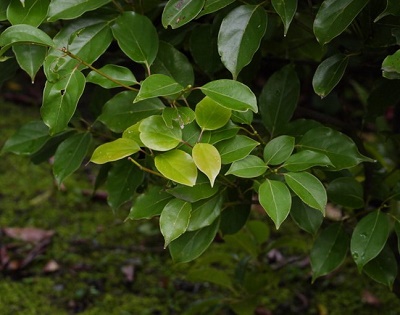Order: Laurales
Family: Lauraceae
General Overview: Cinnamomum kanehirae, also known as Taiwan cinnamon, is a species of evergreen tree in the Lauraceae family. It is native to Taiwan and is also found in parts of southern China.
Morphological Features: Capable of attaining a height of up to 30 m and spreading 2 m in width, these evergreen trees exhibit brown, fissured bark. The branchlets, glabrous and yellow-green, create a distinctive appearance. The leaves, arranged alternately, are coriaceous, entire, and often display wavy margins. With a polished surface, they range from broadly ovate to elliptic, measuring 10–15 cm in length and 4–7.5 cm in width. Both sides of the leaves are green and glabrous, typically featuring 0–3, occasionally 5, main veins, with lateral veins numbering 2–3 pairs. The leaves have a short acute apex and an obtuse-rounded base, while the petioles, measuring 1.4–3 cm, are grooved above. Terminal cymes form the inflorescences, and the bracts of flowers are pubescent outside, approximately 2–3 mm across. The perianth consists of six pale-yellow, oblong segments, each measuring 2 mm and tomentose at the base inside. The 1st and 2nd whorls of stamens, 0.5 mm long, are tomentose at the base inside, featuring 4-celled, eglandular, introrse anthers. The 3rd whorl of stamens bears glands, is tomentose at the base inside, and has 4-celled, extrorse anthers. The berries, either compressed-obconic or globose, range from 1.2–1.3 cm in length and 1.2–1.5 cm in width. Initially green, they mature to a blackish-violet hue and may be slightly pubescent to glabrous. The seeds are globose, measuring 1 cm across, and exhibit a rounded profile on both sides. Flowering occurs from November to December, with fruiting taking place from September to October.
Biological Characteristics:In traditional Chinese medicine, the bark of Cinnamomum kanehirae has been used for its antipyretic, analgesic, and anti-inflammatory properties. It is also used as a digestive aid and to improve blood circulation. Cinnamomum kanehirae is highly valued for its fragrant bark, which is used to produce cinnamon. The tree is cultivated in Taiwan for its bark, which is harvested and processed into cinnamon powder or oil. Taiwan cinnamon is considered to be of high quality and is used in traditional Chinese medicine, cooking, and perfumery. Overall, Cinnamomum kanehirae is a valuable tree with a range of traditional uses and economic importance. Its cultural significance and historical use in traditional Chinese medicine make it an important part of Chinese culture and heritage.

